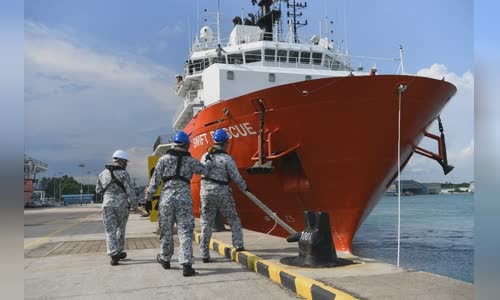The sunken Indonesian submarine shows that limited rescue capacity for the submarine fleet is increasing in Asian waters.
Indonesia's Kri Nanggala submarine was missing on the waters off Bali in the early morning of April 21.
The Indonesian Navy has also distributed the message by supporting partners, but on April 25, Singapore's SWIFT Rescue Submarine rescue ship has just been discovered by Kri Nanggala.
Part of the submarine of Kri Nanggala was found under the seabed on April 25.
Experts evaluating this tragedy to go to a worrying warning bell for many Asia-Pacific countries, in the context of these countries constantly strengthening military capacity and applying anti-invasion doctrines
"The trend focused on underground warfare must be accompanied by multinational efforts to promote cooperation, improve submissions security processes, as well as tools and technical search and rescue",
The submarine rescue methods have been developed since this battleship was payrolled in the major naval forces.
However, there are still a series of tragedies that occur.
Despite advances in the field of rescue, the accident still clings to the force of many submarines.
By 2017, Argentina's Ara San Juan submarine was in distress while moving on the Atlantic Ocean.
This is a modal window.
Beginning of Dialog Window.
End of Dialog Window.
"The cause of disaster is a lot, but almost no way to prevent similar incidents in the future. We will witness more procurement contracts and submarine deployment activities in decades next year
The number of submarines in Indian Ocean - Pacific waters increased by 31% in the period 2000-2021.

Photo: Straits Times
China is seeking the United States in Asia - Pacific by applying an anti-access / anti-intrusion strategy area (A2 / AD), using long-range gas that can be threatened and harmful
In response, the US and allies are increasingly implementing many submarines in the region.
"Asia-Pacific Countries buy as many submarines, the success rate in search and rescue will depend on multilateral cooperation efforts," Danby said.
The Swift Rescue MV ship was about to leave the dock on April 21.
In the effort to rescue Kri Nanggala submarine, in addition to Singapore's MV Swift Rescue, many countries also implement support forces.
However, these efforts are still not enough to promptly save 53 sailors on the submarine Kri Nanggala.
The first is to open the permanent representative office for the International Submarine Leaving Office (Ismerlo) in Indian Ocean and Pacific.
Ismerlo also has an instant alarm system, allowing to mobilize the entire resource in a short time to search and save missing submarines.
Next is to establish a Submarine Rescue System (SRS) ASEAN.
The US can also organize submarine rescue rehearsals with partners, and share the SRDRS system developed to replace Mystic and Avalon.
Danby said that the Kri Nanggala submarine disaster showed that modern technology could not guarantee the entire incident.
"When going to the sea, no matter what uniform or hanging the country, we all understand the fear when in a submarine that is sinking to the seabed. The responsibility of all the seaworthy people is to support them



 Colleen Anora Conant
Colleen Anora Conant







